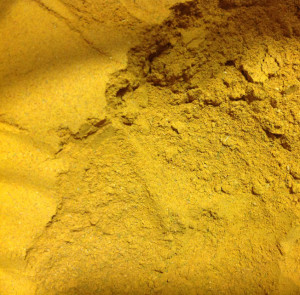
Curry the Spice Versus Curry the Spice Blend

Curry is one complicated flavor. Complicated in that it is both a single spice made from a leaf (Murraya koenigii) and in that it is one of the most complex spice blends around.
Earlier this summer I wrote a bit about curry in an article for Art of Manliness. Here’s a snippet…
Using multiple single ingredient spices has been common in cooking forever. The pre-blending of spices, however, didn’t develop as a widespread commercial venture until the East India Company and the subsequent British Raj between 1757 and 1947. Members of the British Military and their families were returning to England and could not find the flavorful curries and masalas they had experienced in India. Sun Brand Curry was developed in 1876 and is one of the first and most successful spice blends in modern times. This blend became so popular in Europe and America that many people today still don’t know that “curry” is not a single spice, but a spice blend that varies from village to village, clan to clan, and family to family throughout India and Asia.
About that Curry Leaf
Turns out the Curry Leaf is an insignificant ingredient in modern Curry blends. In fact, I’ve sold close to 5 lbs of it in 25 years. Compared to Turmeric (the most misspelled spice there is — people forget the first R) of which I sell thousands of pounds annually through Italco. We carry two varieties of Turmeric; Madras with a 2.0 VO Curcumin level and Alleppey #1 with a 6.5 VO. The color and flavor of each are vastly different. OH! I’m supposed to be telling you about Curry Leaf! Sorry.
Wikipedia has an excellent article on Curry Leaves and the key phrase is, “they have a short shelf life and do not keep well in the refrigerator. They are also available dried, though the aroma is largely inferior.” Which is probably why I have sold so few.
Curry is the original spice blend
 In my work as Spice Master at Italco, I make 9 different varieties of Curry. Subtle ingredients make pronounced differences….and there are lots of ingredients. Curries typically have 12 or more ingredients and as many 26 or 30.
In my work as Spice Master at Italco, I make 9 different varieties of Curry. Subtle ingredients make pronounced differences….and there are lots of ingredients. Curries typically have 12 or more ingredients and as many 26 or 30.
Some have a little bit of Cinnamon, others a bit of Fenugreek, and others very little to no sodium. I could go on and on. The biggest takeaway here is that Curry has regional differences, even family differences if you really drill down.
Regional Curry blend varieties
- Red and Green Curries you see most often in Thai cuisine, with Green having more Lemongrass and Red having more hot Chiles.
- In Malaysia, you have Penang and Red Curries.
- Madras Curry tends to have more Cumin and Coriander for an earthier aroma and taste. Excellent with chicken or vegetables solo or combined.
- Alleppey Curry based upon the aforementioned Alleppey Turmeric is deeper and richer in color and flavor than Madras.
- Berbera Blend is native to East Africa, specifically Somalia and Ethiopia and is extraordinarily hot and spicy with Chilies being the source of the heat instead of Black Pepper. Definitely not for those of the milder palate.
- Bharat from Lebanon has Sumac and Cardamom and a flavor reminiscent of Chai – because of the Cardamom. I have a friend whose family is from Syria who uses this in his restaurant in Avon, Colorado. Chef Adam and his wife Ellie run an outstanding restaurant, The Blue Plate, there that you can mention my name in and he will sell you and excellent meal – well worth the trip.
- Asian garlic curry is for those lovers of the stinking rose that love curry depth of flavor as well. Excellent on almost any protein with tremendous garlic flavor.
Who is hungry for Curry?
Now that you know about Curry, don’t you think it’s time to get cooking with it? It’s simpler than you might think.
Make a roux, add a couple tablespoons of spice, pour in a can of coconut milk, simmer your cooked protein and vegetables, and you have an extraordinary meal. Even a sandwich with Curry mayo could blow your mind. Trust me.
Curry Leaf picture above by Sonja Pauen – Stanhopea (Own work) [CC BY 2.0 de, CC BY-SA 3.0 or GFDL], via Wikimedia Commons





You explained Middle East and Asian curry. What do you say about Caribbean or West Indies curry?